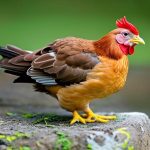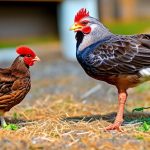Hawks are raptors renowned for their exceptional vision, powerful talons, and adept hunting skills. As natural predators, they present a significant risk to chickens and other small animals. Hawks can dive from the sky at high speeds with remarkable precision, targeting unsuspecting prey.
Their sharp talons enable them to easily capture and carry off chickens, making them a persistent threat to free-range poultry. The danger hawks pose to chickens is heightened by their proficient hunting abilities, which allow them to overpower and kill a chicken rapidly. Hawks are also known for their stealthy approach, often catching prey unaware.
Furthermore, hawks are protected under the Migratory Bird Treaty Act, prohibiting their harm or killing without proper authorization. This legal protection adds complexity to chicken owners’ efforts to safeguard their flocks from these aerial predators. Hawks represent an ongoing threat to chickens due to their innate hunting instincts and protected legal status.
Their capacity to swiftly capture and kill chickens establishes them as formidable predators, necessitating proactive protective measures for poultry safety.
Table of Contents
- 1 Identifying the signs of hawk presence in your area
- 2 Options for protecting your chickens from hawks
- 3 The benefits of using a flag to deter hawks
- 4 How to properly install and use a flag to keep hawks away
- 5 Other methods to consider in conjunction with using a flag
- 6 Maintaining vigilance: Monitoring and adjusting your hawk deterrent strategies
- 7 FAQs
- 7.1 What is a flag to keep hawks away from chickens?
- 7.2 How does a flag to keep hawks away from chickens work?
- 7.3 What are the benefits of using a flag to keep hawks away from chickens?
- 7.4 Are there any potential drawbacks to using a flag to keep hawks away from chickens?
- 7.5 How should a flag to keep hawks away from chickens be installed?
- 7.6 Are there any other methods for protecting chickens from hawks?
Key Takeaways
- Hawks pose a danger to chickens due to their predatory nature and ability to swoop down and attack
- Signs of hawk presence include feathers, droppings, and missing or injured chickens
- Options for protecting chickens from hawks include using netting, building covered shelters, and using visual deterrents like flags
- Using a flag to deter hawks can benefit by creating movement and noise to scare off hawks
- Proper installation and use of a flag involves placing it in a visible and open area, and regularly moving and adjusting its position
- Other methods to consider in conjunction with using a flag include installing scarecrows, using reflective tape, and keeping roosters for protection
- Maintaining vigilance involves regularly monitoring and adjusting hawk deterrent strategies to ensure their effectiveness
Identifying the signs of hawk presence in your area
Feathers and Remains: A Hawk’s Calling Card
One of the most obvious signs of hawk activity is the presence of feathers or remains of prey in the vicinity. Hawks are known for plucking feathers from their prey before consuming them, so finding feathers scattered around your property could indicate the presence of a hawk.
Chicken Behavior: A Hawk’s Presence Felt
Another sign of hawk presence is the behavior of your chickens. If your chickens appear skittish, constantly on edge, or reluctant to leave their coop or sheltered areas, it could be a sign that they sense the presence of a predator such as a hawk. Additionally, if you observe a sudden decrease in the number of chickens in your flock without any other explanation, it could be due to hawk predation.
Wildlife Behavior: A Broader Perspective
Furthermore, observing the behavior of other wildlife in your area can also provide clues about the presence of hawks. For example, if you notice an increase in the number of small birds or rodents in your area, it could be because hawks are preying on them, which in turn attracts more hawks to the area. Being vigilant and observant of these signs can help you take proactive measures to protect your chickens from potential hawk attacks.
Options for protecting your chickens from hawks

There are several options available for protecting your chickens from hawks, ranging from physical barriers to visual deterrents. One effective method is to provide adequate shelter for your chickens, such as a secure coop or run with a roof to prevent hawks from swooping down and snatching them. Additionally, using netting or wire mesh over the top of the chicken enclosure can further deter hawks from gaining access to your flock.
Another option is to use scare tactics such as predator decoys or noise-making devices to deter hawks from approaching your chickens. Predator decoys, such as fake owls or snakes, can create the illusion of danger and discourage hawks from targeting your flock. Similarly, noise-making devices such as wind chimes or motion-activated alarms can startle hawks and make them think twice about hunting in the area.
Furthermore, providing hiding spots and cover for your chickens within their enclosure can help them evade hawk attacks. Dense shrubbery, tall grasses, or artificial shelters can provide refuge for chickens when they sense danger from above. Implementing a combination of these options can significantly reduce the risk of hawk predation and keep your chickens safe.
The benefits of using a flag to deter hawks
Using a flag as a deterrent against hawks has proven to be an effective and non-invasive method for protecting chickens. The movement and reflective properties of a flag can create visual disturbances that deter hawks from approaching an area. The fluttering motion of a flag in the wind mimics the movement of a larger predator, which can intimidate hawks and discourage them from hunting in the vicinity.
Additionally, flags with reflective surfaces can create flashes of light that disorient and startle hawks, making them less likely to target an area with such visual disturbances. This visual deterrent is a passive yet powerful method for keeping hawks at bay without causing harm to the birds or disrupting the natural ecosystem. Another benefit of using a flag as a hawk deterrent is its versatility and ease of use.
Flags can be easily installed in various locations around your property, such as near chicken coops, run enclosures, or open fields where chickens roam. They can also be moved and repositioned as needed to maximize their effectiveness in deterring hawks from targeting your flock.
How to properly install and use a flag to keep hawks away
Proper installation and use of a flag as a hawk deterrent are essential for maximizing its effectiveness in protecting your chickens. When installing a flag, it is important to position it in an open area where it can catch the wind and create movement. This movement is crucial for simulating the presence of a larger predator and deterring hawks from approaching.
Flags should be installed at varying heights to create visual disturbances at different levels, as hawks often hunt from different altitudes depending on their species and hunting techniques. By installing flags at different heights, you can create a more comprehensive deterrent that covers a wider range of potential hawk attack angles. Furthermore, using flags with reflective surfaces can enhance their effectiveness in deterring hawks.
Reflective flags can create flashes of light that disorient and startle hawks, making them less likely to target an area with such visual disturbances. It is important to regularly inspect and maintain flags to ensure that they remain visible and effective in deterring hawks from targeting your chickens.
Other methods to consider in conjunction with using a flag

Visual Deterrents and Decoys
Using a flag as a hawk deterrent can be highly effective, but combining it with other methods can further enhance the protection of your chickens. One complementary method is the use of predator decoys such as fake owls or snakes, which can create the illusion of danger and discourage hawks from targeting your flock.
Noise-Making Devices and Alarms
Another method to consider is the use of noise-making devices such as wind chimes or motion-activated alarms. These devices can startle hawks and make them think twice about hunting in the area, especially when used in conjunction with visual deterrents like flags.
Providing Shelter and Cover
Providing adequate shelter and cover for your chickens within their enclosure can help them evade hawk attacks. Dense shrubbery, tall grasses, or artificial shelters can provide refuge for chickens when they sense danger from above.
A Comprehensive Hawk Deterrent Strategy
Implementing a combination of these methods can create a comprehensive hawk deterrent strategy that significantly reduces the risk of predation and keeps your chickens safe.
Maintaining vigilance: Monitoring and adjusting your hawk deterrent strategies
Maintaining vigilance is crucial for effectively protecting your chickens from hawk predation. Regularly monitoring the behavior of your chickens and observing signs of hawk presence in your area can help you identify any potential threats and adjust your deterrent strategies accordingly. It is important to regularly inspect and maintain visual deterrents such as flags to ensure that they remain visible and effective in deterring hawks.
Flags should be repositioned as needed to maximize their effectiveness in deterring hawks from targeting your flock. Furthermore, staying informed about local hawk populations and their hunting behaviors can help you anticipate potential threats and take proactive measures to protect your chickens. Consulting with local wildlife experts or poultry professionals can provide valuable insights into effective hawk deterrent strategies specific to your area.
By maintaining vigilance and regularly adjusting your hawk deterrent strategies, you can effectively protect your chickens from potential predation and ensure their safety and well-being.
If you’re looking for ways to keep hawks away from your chickens, you may want to check out this article on how to build a secure chicken coop in Grand Island, NE. A well-constructed coop can provide protection for your chickens from predators like hawks.
FAQs
What is a flag to keep hawks away from chickens?
A flag to keep hawks away from chickens is a visual deterrent that is used to scare off hawks and other birds of prey from attacking and preying on chickens.
How does a flag to keep hawks away from chickens work?
The flag works by creating movement and reflecting light, which can startle and deter hawks and other birds of prey from approaching the area where the chickens are kept.
What are the benefits of using a flag to keep hawks away from chickens?
Using a flag to keep hawks away from chickens can help protect the chickens from potential attacks by hawks and other birds of prey, reducing the risk of injury or loss of chickens.
Are there any potential drawbacks to using a flag to keep hawks away from chickens?
While flags can be effective in deterring hawks, they may not work in all situations or with all types of hawks. Additionally, flags may need to be regularly moved or adjusted to maintain their effectiveness.
How should a flag to keep hawks away from chickens be installed?
Flags should be installed in the area where the chickens are kept, such as around the perimeter of a chicken coop or run. They should be positioned to catch the wind and create movement.
Are there any other methods for protecting chickens from hawks?
In addition to using flags, other methods for protecting chickens from hawks include providing overhead cover, such as netting or wire mesh, and keeping the chickens in a secure and enclosed area.
Meet Walter, the feathered-friend fanatic of Florida! Nestled in the sunshine state, Walter struts through life with his feathered companions, clucking his way to happiness. With a coop that’s fancier than a five-star hotel, he’s the Don Juan of the chicken world. When he’s not teaching his hens to do the cha-cha, you’ll find him in a heated debate with his prized rooster, Sir Clucks-a-Lot. Walter’s poultry passion is no yolk; he’s the sunny-side-up guy you never knew you needed in your flock of friends!







